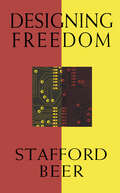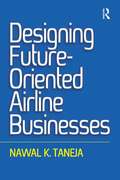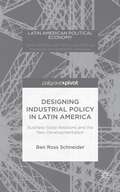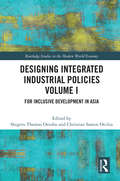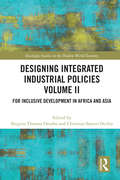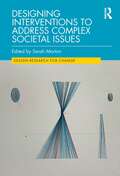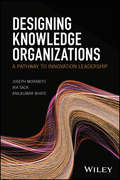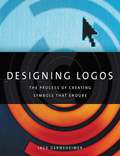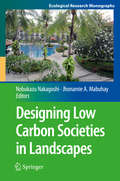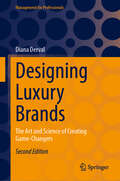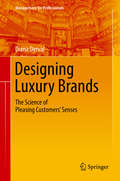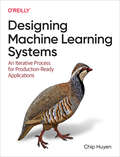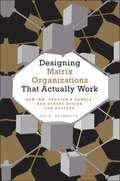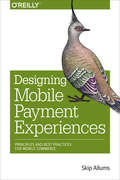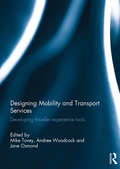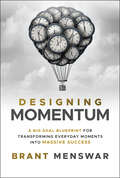- Table View
- List View
Designing Food Safety and Equipment Reliability Through Maintenance Engineering
by Sauro RiccettiExisting maintenance engineering techniques pursue equipment reliability with a focus on minimal costs, but in the food industry, food safety is the most critical issue. This book identifies how to ensure food product safety through maintenance engineering in a way that produces added value and generates real profits for your organization.Integrati
Designing Freedom (The CBC Massey Lectures)
by Stafford BeerDistinguished cyberneticist Stafford Beer states the case for a new science of systems theory and cybernetics. His essays examine such issues as The Real Threat to All We Hold Most Dear, The Discarded Tools of Modern Man, A Liberty Machine in Prototype, Science in the Service of Man, The Future That Can Be Demanded Now, The Free Man in a Cybernetic World. Designing Freedom ponders the possibilities of liberty in a cybernetic world.
Designing Future-Oriented Airline Businesses
by Nawal K. TanejaDesigning Future-Oriented Airline Businesses is the eighth Ashgate book by Nawal K. Taneja to address the ongoing challenges and opportunities facing all generations of airlines. Firstly, it challenges and encourages airline managements to take a deeper dive into new ways of doing business. Secondly, it provides a framework for identifying and developing strategies and capabilities, as well as executing them efficiently and effectively, to change the focus from cost reduction to revenue enhancement and from competitive advantage to comparative advantage. Based on the author’s own extensive experience and ongoing work in the global airline industry, as well as through a synthesis of leading business practices both inside and outside of the industry, Designing Future-Oriented Airline Businesses sets out to demystify numerous concepts being discussed within the airline industry and to facilitate managements to identify and articulate the boundaries of their business models. It provides material from which managements can set about answering the key questions, especially with respect to strategies, capabilities and execution, and pursue an effective redesign of their business. As with the author’s previous books, the primary audience is senior-level practitioners of differing generations of airlines worldwide as well as related businesses. The material presented continues to be at a pragmatic level, not an academic exercise, to lead managements to ask themselves and their teams some critical thought-provoking questions.
Designing Futures: Bridging Creativity, Sustainability, and Technology in Education and Industry (Advances in Science, Technology & Innovation)
by Angeles Sánchez Marina Checa Olivas Saimir Shtylla Antonio Maffei Claudio SassanelliThis book is a compelling exploration into the integration of sustainability with creativity and technology. It offers a cohesive journey from theoretical insights into practical applications across creative disciplines, education, and industries. This book serves as a crucial guide for those looking to navigate the challenges of modern sustainability through innovative solutions. By showcasing examples from 3D printing in education to sustainable practices in creative industries and the preservation of cultural heritage through digital innovation, it highlights the transformative power of creativity in fostering a sustainable future. Aimed at academics, professionals, and students, this book is an invitation to engage, innovate, and contribute to the sustainability discourse in the creative sectors.
Designing Green Networks and Network Operations: Saving Run-the-Engine Costs
by Daniel MinoliIn recent years, socio-political trends toward environmental responsibility and the pressing need to reduce Run-the-Engine (RTE) costs have resulted in the concept of Green IT. Although a significant amount of energy is used to operate routing, switching, and transmission equipment, comparatively less attention has been paid to Green Networking. A
Designing Green Spaces for Health: Using Plants to Reduce the Spread of Airborne Viruses
by Stevie FamulariThis book focuses on using plants in spatial design to reduce the infectiousness of viruses in different working and living spaces. It presents strategies for interior and exterior green designs with plants that are likely effective for flu virus tolerance and reduction of infectiousness. The designs are appealing for interaction and healing, as well as focusing on the reduction and removal of virus infectiousness. The Famulari Theory requires examining plants that are likely effective for virus accumulation based on their leaves with stomata, trichomes, and dense leaf growth, and transpiration rate accumulation of airborne viruses. In addition, this research requires reviewing the quantity and specific types of plants (as well as electronic sources, such as humidifiers and water features) needed to produce effective humidity for plants to decrease the infectiousness or transmission of viruses; the effective distance of people to plants; and light, water, soil, and temperature needs. The book addresses the various greening practices that can be applied to sites to reduce the infectiousness of the airborne flu virus – especially in areas such as train stations, restaurants, rooftops, courtyards, office buildings and work spaces/conference rooms, and the home office – and the ways that businesses owners and residents can integrate these practices to reduce the air contaminants with a green solution. Designing green spaces that accumulate, reduce, and remove the infectiousness of viruses involves exploring multiple approaches from different directions to achieve the most effective and ideal design. The six basic approaches include 1. Temperature minimum of 70° Fahrenheit 2. Plants with multiple stomata on the leaf surfaces 3. Plants with multiple clumps of dense leaves with a high transpiration rate 4. Plants with rough leaf surfaces or with trichomes (plant hairs) on the leaf 5. Relative humidity (RH) minimum of 43% or higher 6. Air circulation to direct air with the airborne flu virus to the planted areas Stevie Famulari brings unique insights and inspires the development of green understanding and design solution plans with both short-term and long-term approaches. Illustrations of greening applied to locations help you understand your own design solutions to create them in your site. This book breaks down the misconceptions of the complexity of sustainability and green practices and provides illustrations and site-appropriate green solutions that you can incorporate into your lifestyle for a healthier site. Greening is a lifestyle change, and this guide lets you know how easy it is to transition to the green side to improve your health.
Designing Human Resource Management Systems
by Jayant MukherjeeDesigning Human Resource Management Systems provides a framework for designing and implementing Human Resource Management (HRM) systems in various kinds of organizations, even those with limited resources. It is intended for leaders, decision makers, senior managers, HR practitioners, and consultants wishing to innovate, structure, and implement HRM systems in organizations. Distinguishing features of the book are: - Guidelines in each of the practice areas of HRM that identify key components and discuss important considerations in designing the sub-system of that practice area. - Exhibits in the form of tools, questionnaires, inventories, forms, policies, and other aspects of utility for designing HRM systems. - Key Terms and Concepts section in each chapter that provides relevant theory, concepts, and research in each practice area. The book comprehensively covers concepts and relevant theories pertaining to job analysis, human resource planning, recruitment and selection, performance management, training and development, 360-degree feedback, mentoring and executive coaching, and reward management. The guidelines present a logical, simple, and easy-to-adopt approach with examples related to what can possibly go wrong and therefore what to guard against.
Designing Hybrid Learning Environments and Processes: Interactive Communication Tools for Active Learning (SpringerBriefs in Applied Sciences and Technology)
by Andrea ManciaracinaThis volume explores the relationship between space, pedagogy, and technology, with a particular focus on the latter since it is the connecting element that relates to all analysed contexts. The learning experience is investigated and supported by a review of works by referenced authors, underlining the active learning approach that can create better alliances among users and redefine the role of the teacher as a director and a facilitator. The volume offers a conceptualisation of learning technologies for innovative learning environments by creating a grid of technologies for active approaches. Then, it reflects on the comparison between the on-site and online learning environments, focusing on a stressful context. It offers and discusses an instructional design tool that supports teachers in designing hybrid learning contexts. Practitioners who wish to reframe technology in teaching using both digital and physical resources will find it very inspiring.
Designing Industrial Policy in Latin America: Business-State Relations and the New Developmentalism
by Ben Ross SchneiderDevelopment economists and practitioners agree that close collaboration between business and government improves industrial policy, yet little research exists on how best to organize that. This book examines three necessary functions--information exchange, authoritative allocation, and reducing rent seeking--across experiences in Latin America.
Designing Innovative Corporate Water Risk Management Strategies from an Ecosystem Services Perspective
by Emily Taylor Berry Kennedy Don Scavia Makely Lyon Joshua Rego Daniel Gerding Andrew Hoffman Neil HawkinsAccess to water is essential for almost all aspects of the economy and quality of life; in particular, for health, food production and security, domestic water supply and sanitation, energy, industry, and ecosystem health. Yet, water scarcity already affects more than 40 percent of the global population, and by 2025, it is estimated that and two-thirds of the world’s population will be living in regions where water supplies are stressed and 1.8 billion people will be living in countries or regions with absolute water scarcity. By 2030, it is estimated that 47 percent of the global population will be living in high water stress areas. The authors of this book survey common organizational (both public and private) responses to water scarcity across three categories--technology-based, policy-based, and management-based--and then focus on the latter as holding the most promise for creating a robust, organization-wide solution for potential freshwater scarcity. Management-based responses are those developed within the organization to internalize water-related externalities.
Designing Integrated Industrial Policies Volume I: For Inclusive Development in Asia (Routledge Studies in the Modern World Economy)
by Shigeru Thomas OtsuboThis comprehensive reference work gives an overview of the industrial development and current state of industrialization and deindustrialization in Asia, specifically Southeast Asia and China. It introduces typologies of industrial policies and discusses the manufacturing sector and its evolving role in the region. Designing Integrated Industrial Policies examines the integration of SMEs in global value chains and provides macro-econometric and firm-based micro-econometric analyses of (de)industrialization. This book will be a very useful reference particularly as a how-to guide on industrial promotion and designing integrated industrial policies not only for economic growth and job creation but also for "inclusive" development. It presents country cases and illustrates useful tools for industrial policy simulation and for evidence-based policy making through these concrete examples.
Designing Integrated Industrial Policies Volume II: For Inclusive Development in Africa and Asia (Routledge Studies in the Modern World Economy)
by Shigeru Thomas OtsuboVery little has been written on industrialization and deindustrialization in Asia and Africa. This reference work sheds illuminating light upon the industrial development in Asia and Africa. It also provides an in-depth look into China’s engagement and migrant labour in Africa. The book also addresses the roles of public-private partnership (PPP) and international development cooperation and how they are fundamental to industrialization in Asia and Africa. Designing Integrated Industrial Policies will be a very useful reference particularly as a how-to guide on industrial promotion and designing integrated industrial policies not only for economic growth and job creation but also for "inclusive" development. It comes with country cases and illustrates useful tools for industrial policy simulation and for evidence-based policy making through these concrete examples.
Designing Interventions to Address Complex Societal Issues (Design Research for Change)
by Sarah MortonThis edited volume is about the application of design-led approaches for developing interventions that have the intention of addressing real-world issues and problems. The book documents the realities of developing and designing interventions for real people, in a real-world context. The topics covered in the book are multi-disciplinary, and include examples from health and wellbeing, education, and agriculture. The contributors provide open and honest accounts of the challenges and restrictions, highlighting the positive impact that can be gained from involving stakeholders as key voices in the intervention development process. These case studies suggest underpinning methodologies that will support the formalisation of these design-led approaches, permitting the formation of robust frameworks in the future. The book will be of interest to scholars working in design, design research, intervention design, co-design, user-centred design, service design, digital design, digital healthcare, and evidence-based design.
Designing Knowledge Management-Enabled Business Strategies
by Sanjay Mohapatra Arjun Agrawal Anurag SatpathyThis book provides a practical approach to designing and implementing a Knowledge Management (KM) Strategy. The book explains how to design KM strategy so as to align business goals with KM objectives. The book also presents an approach for implementing KM strategy so as to make it sustainable. It covers all basic KM concepts, components of KM and the steps that are required for designing a KM strategy. As a result, the book can be used by beginners as well as practitioners. Knowledge management is a discipline that promotes an integrated approach to identifying, capturing, evaluating, retrieving, and sharing all of an enterprise's information assets. These assets may include databases, documents, policies, procedures, and previously un-captured expertise and experience in individual workers. Knowledge is considered to be the learning that results from experience and is embedded within individuals. Sometimes the knowledge is gained through critical thinking, watching others, and observing results of others. These observations then form a pattern which is converted in a 'generic form' to knowledge. This implies that knowledge can be formed only after data (which is generated through experience or observation) is grouped into information and then this information pattern is made generic wisdom. However, dissemination and acceptance of this knowledge becomes a key factor in knowledge management. The knowledge pyramid represents the usual concept of knowledge transformations, where data is transformed into information, and information is transformed into knowledge. Many organizations have struggled to manage knowledge and translate it into business benefits. This book is an attempt to show them how it can be done.
Designing Knowledge Organizations: A Pathway to Innovation Leadership
by Anilkumar Bhate Ira Sack Joseph MorabitoA pedagogical approach to the principles and architecture of knowledge management in organizations This textbook is based on a graduate course taught at Stevens Institute of Technology. It focuses on the design and management of today’s complex K organizations. A K organization is any company that generates and applies knowledge. The text takes existing ideas from organizational design and knowledge management to enhance and elevate each through harmonization with concepts from other disciplines. The authors—noted experts in the field—concentrate on both micro- and macro design and their interrelationships at individual, group, work, and organizational levels. A key feature of the textbook is an incisive discussion of the cultural, practice, and social aspects of knowledge management. The text explores the processes, tools, and infrastructures by which an organization can continuously improve, maintain, and exploit all elements of its knowledge base that are most relevant to achieve its strategic goals. The book seamlessly intertwines the disciplines of organizational design and knowledge management and offers extensive discussions, illustrative examples, student exercises, and visualizations. The following major topics are addressed: Knowledge management, intellectual capital, and knowledge systems Organizational design, behavior, and architecture Organizational strategy, change, and development Leadership and innovation Organizational culture and learning Social networking, communications, and collaboration Strategic human resources; e.g., hiring K workers and performance reviews Knowledge science, thinking, and creativity Philosophy of knowledge and information Information, knowledge, social, strategy, and contract continuums Information management and intelligent systems; e.g., business intelligence, big data, and cognitive systems Designing Knowledge Organizations takes an interdisciplinary and original approach to assess and synthesize the disciplines of knowledge management and organizational design, drawing upon conceptual underpinnings and practical experiences in these and related areas.
Designing Logos: The Process of Creating Symbols That Endure
by Jack GernsheimerHow to design great logos, step by step by step. * Lavishly illustrated with 750 color images * How-tos, case studies, and detailed analysis of well-known logos What makes a logo good? What makes it bad? What makes it great? The entire process of logo design is examined, from the initial client interview to brainstorming, from first presentation to delivery of the final standards manual. Through 750 color illustrations, classic logos are analyzed, and readers will learn a thirteen-point system for measuring the effectiveness of any logo. Learn about the uses of positive and negative space, balance, color, and typography; follow intriguing case studies; discover how to make effective presentations to clients. Designers, marketing and branding specialists, educators, and students everywhere need this definitive guide to creating great logos.
Designing Low Carbon Societies in Landscapes
by Nobukazu Nakagoshi Jhonamie A. MabuhayThis book focuses on three major means of achieving a low carbon society: conservation of the ecosystem complex, changes of arrangement of landscapes, and creation of biodiversity. There are specific countermeasures to be taken for carbon absorption in the three types of landscapes--urban, cultural, and natural--because their carbon balances differ. Urban landscapes are promising sites because they have the potential for greening and the creation of biodiversity. Cultural landscapes in the tropics had not been actively researched until recently, but this book now presents a collection of several cases focused on those areas. Natural landscapes had existed in abundance in developing countries; later, nature protection areas were designated to coexist with development. Now, however, developmental pressure has penetrated into those nature protection areas, and landscape ecological projects are urgently required to preserve them. As a result of global warming, abnormal weather phenomena including super typhoons have occurred frequently in recent years. The major underlying cause is the higher concentration of greenhouse gases released by human activities. As well, major natural absorbers of CO2 such as forests, wetlands, and coral reefs are shrinking, and the human impact is causing the ecological balance to deteriorate. Controlling CO2 emissions and expanding the CO2 absorbers are keys to reducing total CO2. Low carbon societies can be established by maintaining the original CO2 balance through integration of multiple tools, with contributions from diverse fields such as physics and chemistry, physiology and humanities, and education. On the basis of an international consensus, the environment must be protected no matter what sacrifices are required. As this book demonstrates, achieving a low carbon society is a top priority, and landscape conservation is the first step in ecological research toward that goal.
Designing Luxury Brands: The Art and Science of Creating Game-Changers (Management for Professionals)
by Diana DervalThis book, a second offering after the successful first edition, shows how to build successful luxury brands using the power of sensory science and neuropsychology. The author presents inspiring business cases like Tesla Cybertruck, Chanel, KaDeWe, Baccarat, JACQUEMUS, NASA, MUD Jeans, Lilium, Rémy Cointreau, FENG J, Moncler, Louboutin, or Raffles Dubai in industries such as Fashion, Automotive or Leisure. The book highlights groundbreaking scientific methods - like the Derval Color Test® taken by over 30 million people - to help predict luxury shoppers’ preferences and purchasing patterns. Game-changing and unique features of successful luxury brands are decoded. Through various practical examples and experiments, readers will be able to build, revamp, or expand luxury brands and look at luxury from a new angle.
Designing Luxury Brands: The Science Of Pleasing Customers' Senses (Management For Professionals)
by Diana DervalThis book shows how to build successful luxury brands using the power of sensory science and neuro-physiology. The author introduces – based on inspiring business cases like Tesla, Louis Vuitton, Chanel, Hermès, Moncler, Louboutin, or Sofitel in industries such as Fashion, Automotive or Leisure – groundbreaking scientific methods - like the Derval Color Test® taken by over 10 million people - to predict luxury shoppers’ preferences and purchasing patterns and illustrates common and unique features of successful luxury brands. Through various practical examples and experiments, readers will be able to build, revamp, or expand luxury brands and look at luxury from a new angle.
Designing Machine Learning Systems: An Iterative Process for Production-Ready Applications
by Chip HuyenMachine learning systems are both complex and unique. Complex because they consist of many different components and involve many different stakeholders. Unique because they're data dependent, with data varying wildly from one use case to the next. In this book, you'll learn a holistic approach to designing ML systems that are reliable, scalable, maintainable, and adaptive to changing environments and business requirements.Author Chip Huyen, co-founder of Claypot AI, considers each design decision--such as how to process and create training data, which features to use, how often to retrain models, and what to monitor--in the context of how it can help your system as a whole achieve its objectives. The iterative framework in this book uses actual case studies backed by ample references.This book will help you tackle scenarios such as:Engineering data and choosing the right metrics to solve a business problemAutomating the process for continually developing, evaluating, deploying, and updating modelsDeveloping a monitoring system to quickly detect and address issues your models might encounter in productionArchitecting an ML platform that serves across use casesDeveloping responsible ML systems
Designing Matrix Organizations that Actually Work
by Jay R. GalbraithOrganization structures do not fail, says Jay Galbraith, but management fails at implementing them correctly. This is why, he explains, the idea that the matrix does not work still exists today, even among people who should know better. But the matrix has become a necessary form of organization in today's business environment. Companies now know that if they have multiple product lines, do business in multiple countries, and serve many customer segments through a variety of channels, there is no way they can avoid some kind of a matrix structure and the question most are asking is "How do we learn how to operate the matrix effectively?" In Designing Matrix Organizations That Actually Work, Galbraith answers this and other questions as he shows how to make a matrix work effectively.
Designing Mobile Payment Experiences: Principles and Best Practices for Mobile Commerce
by Skip AllumsNow that consumer purchases with mobile phones are on the rise, how do you design a payment app that’s safe, easy to use, and compelling? With this practical book, interaction and product designer Skip Allums provides UX best practices and recommendations to help you create familiar, friendly, and trustworthy experiences.Consumers want mobile transactions to be as fast and reliable as cash or bank cards. This book shows designers, developers, and product managers—from startups to financial institutions—how to design mobile payments that not only safeguard identity and financial data, but also provide value-added features that exceed customer expectations.Learn about the major mobile payment frameworks: NFC, cloud, and closed loopExamine the pros and cons of Google Wallet, Isis, Square, PayPal, and other payment appsProvide walkthroughs, demos, and easy registration to quickly gain a new user’s trustDesign efficient point-of-sale interactions, using NFC, QR, barcodes, or geolocationAdd peripheral services such as points, coupons and offers, and money management
Designing Mobility and Transport Services: Developing traveller experience tools
by Mike Tovey Andree Woodcock Jane OsmondEuropean cities increasingly face problems caused by transport and traffic. For many people transport provision is unsatisfactory and current arrangements are leading to a deteriorating environment. A fundamental problem is that our currently fragmented approach makes it difficult to understand fully the circumstances and needs of transport users. In any overall approach public transport is a crucial component. Designing Mobility and Transport Services shows how these issues can be addressed and resolved. The development of an inclusive, validated passenger experience measurement instrument is the first step in understanding the situation and thus tackling it. It is needed if we are to create high quality, user centred, integrated, accessible public transport services, which are capable of attracting and retaining public transport users whilst meeting sustainability targets. The METPEX research project was devised to tackle these issues. Coordinated by Coventry University, the METPEX consortium brought together 16 European partners from 12 countries. The project’s underlying rationale was the proposition that if transport operators and authorities were provided with a robust, reliable and tailorable means of measuring the whole multimodal passenger journey, they could improve service provision. The book describes how such an improvement can be achieved, to attract travellers out of their private vehicles, thereby reducing congestion and pollution and increasing health and well-being. It provides a template for a creative approach and a meta-design narrative in designing for transport systems to enhance mobility choices by improving the door to door journey and thus underpin sustainable transport initiatives.
Designing Momentum: A Big Goal Blueprint for Transforming Everyday Moments into Massive Success
by Brant MenswarMaster life's pivotal moments to create a legacy of unstoppable momentum Discover how Brant Menswar's Designing Momentum can transform your life by teaching you to capture and harness the power of everyday moments. In a world where uncertainty reigns, this motivational guide provides the mindsets and strategies you need for lasting personal and professional growth. Designing Momentum is your practical guide to recognizing and leveraging life's transformational moments for maximum impact. Through engaging stories and actionable advice, Menswar shows you how to use Moment Momentum to propel yourself toward your goals, creating a legacy worth remembering. Inside the book: Adopt the WITWAW Mindset: Cultivate a “What If There Was A Way” approach to turn probabilities into possibilities. Harness the BUMP Framework: Build momentum through belonging, understanding, meaning, and purpose. Leverage the power of OGREs: Unleash moments filled with an Overwhelming Gut Reaction of Emotion for tremendous impact. Designing Momentum is perfect for anyone seeking to elevate their life from ordinary to extraordinary. Whether you're an entrepreneur, a corporate leader, or simply someone who desires personal growth and greater fulfillment, this book will guide you toward realizing your potential one moment at a time.
Designing Monetary and Fiscal Policy in Low-Income Countries
by Shamsuddin Tareq Jan Kees Martijn Gabriel Di BellaA report from the International Monetary Fund.

